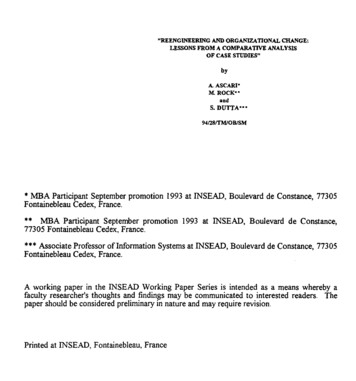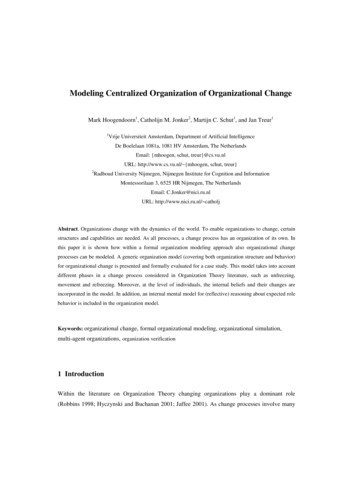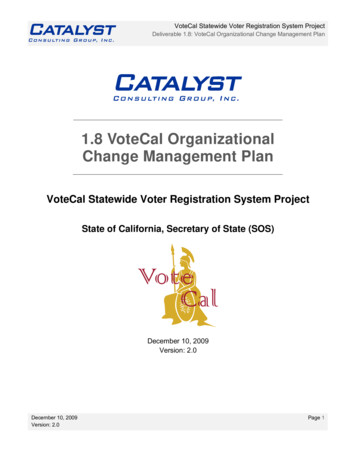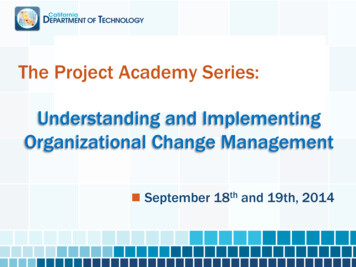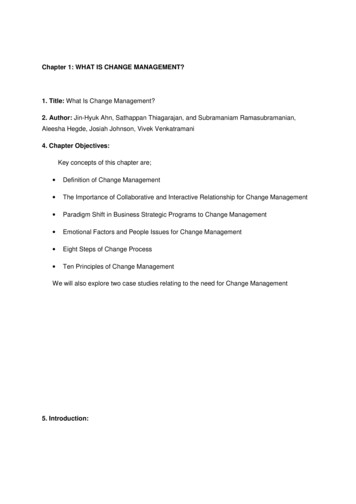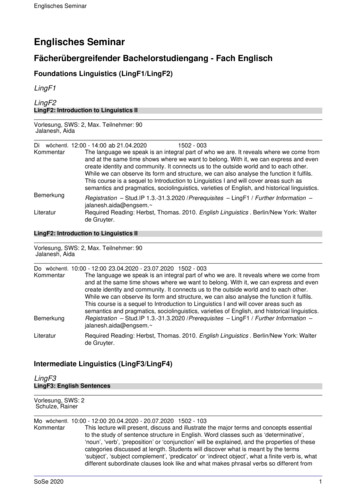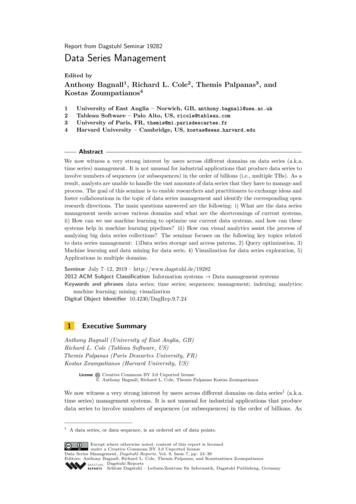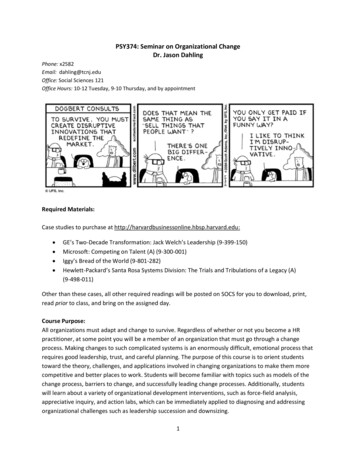
Transcription
PSY374: Seminar on Organizational ChangeDr. Jason DahlingPhone: x2582Email: dahling@tcnj.eduOffice: Social Sciences 121Office Hours: 10-12 Tuesday, 9-10 Thursday, and by appointmentRequired Materials:Case studies to purchase at http://harvardbusinessonline.hbsp.harvard.edu: GE’s Two-Decade Transformation: Jack Welch’s Leadership (9-399-150)Microsoft: Competing on Talent (A) (9-300-001)Iggy’s Bread of the World (9-801-282)Hewlett-Packard’s Santa Rosa Systems Division: The Trials and Tribulations of a Legacy (A)(9-498-011)Other than these cases, all other required readings will be posted on SOCS for you to download, print,read prior to class, and bring on the assigned day.Course Purpose:All organizations must adapt and change to survive. Regardless of whether or not you become a HRpractitioner, at some point you will be a member of an organization that must go through a changeprocess. Making changes to such complicated systems is an enormously difficult, emotional process thatrequires good leadership, trust, and careful planning. The purpose of this course is to orient studentstoward the theory, challenges, and applications involved in changing organizations to make them morecompetitive and better places to work. Students will become familiar with topics such as models of thechange process, barriers to change, and successfully leading change processes. Additionally, studentswill learn about a variety of organizational development interventions, such as force-field analysis,appreciative inquiry, and action labs, which can be immediately applied to diagnosing and addressingorganizational challenges such as leadership succession and downsizing.1
Course Prerequisites:Because success in this course depends on having a good grasp of the basics of organizational behavior,students must have already completed PSY267 (Organizational Psychology) or MGT301 (OrganizationalBehavior) prior to enrolling.Learning Objectives: Learn the major theoretical perspectives taken to understand change processesBecome familiar with some of the more popular process models of change that are used inbusinessGain a strategic awareness of the potential barriers to change that exist within organizationsUnderstand the complementary roles that leaders and employees have in the change processBecome aware of your own personal characteristics that might make it hard for you to lead achange processLearn a set of intervention tools that can be applied to develop organizationsLearn about how change theory can inform large, system-level changes, such as downsizingAssignments and Communication:Readings will be posted on SOCS for you to download. It is your responsibility to print these articles,read them, and bring them to class. I will also use SOCS for all course communication. If you do not useyour TCNJ e-mail account, please forward e-mail from that account to the account that you checkregularly.Course Assignments & Assessment:1. Exams. Two exams will be given during the course, one as a midterm and one on the last day ofclasses. Exams are not cumulative; the second exam will only cover material discussed after themidterm. Each exam includes both an in-class and a take-home component. The in-classcomponent (70 points) will consist of short answer questions. The take-home component (30points) will consist of an essay question. For the midterm, the essay question will be providedafter the exam and will be due at the following class meeting. For the final, the essay questionwill be provided on the next-to-last class meeting and will be due on the day of the test.Responses to the essay are not to exceed four double-spaced, single-sided pages. The takehome essay is (obviously) open book, although you are expected to complete it individually.Plagiarism will be handled in accordance with the College policy – see the selection below onAcademic Integrity for clarification.2. Discussion Facilitation. Working with a partner, each student will lead the discussion on aselected day of class. Discussion leaders are responsible for providing a very short overview (1-2minutes) of their reading(s), followed by a series of questions designed to generate 20-30minutes of discussion. You are to ask, not answer, your questions, so focus on developingquestions that will encourage discussion. Discussion questions should not be exam-typequestions that test recall (e.g., “what are the five good characteristics of an appraisal system inTable 2?”), but rather questions designed to elicit conversation or elaboration on an issue orpoint. You are responsible for sending me a copy of your discussion questions by the classmeeting prior to your assigned discussion day.2
3. Class Participation. Much of the change literature is non-empirical, and thus highly opinionated.It is your responsibility to read and think about the articles so that you can contribute to ourdiscussion of the points that they raise. Being a part of the conversation is a very important partof this class! Attendance does not constitute participation.4. Research Proposal. As a response to the lack of good research in the change literature, you willindividually develop a proposal for an empirical research project that could explore or test aclaim made in a class reading. You can propose either a quantitative or qualitative design. Yourfinal product will consist of an introduction section that sets up the hypotheses or questions youwould examine, along with a proposed methods section that details how you would go aboutcollecting this data. Further details will be provided later in the course.5. Group project: TCNJ. TCNJ is the one organization that has undergone a major change processthat all of you can access. Accordingly, you will research the history of the transformation ofTrenton State University into TCNJ for this project, which serves as the cumulative assignmentfor the course. Your responsibilities will include interviewing faculty and staff who lived throughthis change in a group setting, although each person will be responsible for producing anindividual reaction paper. Further details will be provided later in the course.Exams: 2 at 100 points eachDiscussion FacilitationClass ParticipationResearch ProposalGroup Project200 points25 points75 points75 points75 points450 pointsTOTAL:EARNED PERCENTAGETOTALCOURSEEARNEDPERCENTAGE TOTALCOURSE93-100%A73-76%C90-92%A-70-72%C-87-89%B 67-69%D 83-86%B60-66%D80-82%B- 60%F77-79%C GRADEGRADELate Policy:The syllabus notes the dates of tests and due dates of projects. I set these deadlines well in advance sothat you should have no problems meeting them. Accordingly, make-up exams and quizzes will not beprovided except in extreme extenuating circumstances, defined at my discretion, and in all casessupported with documentation. Because analysis papers are due at the end of the semester, late paperswill not be accepted under any circumstances.3
Attendance and Participation:Attendance is expected in accordance with College policies. Regular attendance and participation will betaken into consideration in the case of a borderline grade. Further, class time will be used to work onactivities that will influence your grades. If you do miss class, it is your responsibility to contact a classmember to find out what you missed. Please do not e-mail me to inform me that you will be absentfrom a class. As adults, I assume that if you have made the decision to miss the class then you have animportant reason. However, I do not need to know that reason. Please do not e-mail me and ask mewhat you have missed or if I will be covering anything important. Every class period is important and itis not possible for me to summarize in an e-mail what I will cover in an entire class period. If, aftercontacting a classmate and getting the notes from him/her, you still have questions or need anyinformation, then please see me. The success of this class depends on your active participation, and Iexpect each student to regularly participate in class discussions and to raise any questions whennecessary.Note that when quizzes are administered, they are given at the beginning of class. Students who aretardy will not be allowed to make up missed quizzes.Academic IntegrityCheating and Plagiarism are serious violations of the college’s Academic Integrity Policy and will be dealtwith accordingly. Any student found cheating or plagiarizing will receive a zero for that assignment, quiz,or exam, and further action may be taken in accordance with the college’s policy. It is your responsibilityto familiarize yourself with the College’s policy on Academic Integrity, available in full here:http://www.tcnj.edu/ academic/policy/integrity.html4
Tentative ScheduleDateJan222629Feb25912Topics & Reading for ClassSyllabus, introduction to course frameworkReading:Kotter, J.P. (2007). Leading change. Harvard Business Review, 85, 96103.Foundation:Why, how, & when change happensWhy change is importantReadings:GE’s two-decade transformation (HBS case)Taylor, A. (2008, December 8). GM and me. Fortune, 158(11), 92-100.Permanence of change in organizationsReadings:Leana, C.R., & Barry, B. (2000). Stability and change as simultaneousexperiences in organizational life. Academy of Management Review,25, 753-759.Senge, P. (1990). The Fifth Discipline, Chapter 4The shape of changeReading:Tushman, M.L., & O’Reilly, C.A. (1996). Ambidextrous organizations:Managing evolutionary and revolutionary change. CaliforniaManagement Review, 38, 8-30.The timing of changeReading:Suarez, F.F., & Lanzolla, G. (2007). The role of environmental dynamicsin building a first mover advantage theory. Academy of ManagementReview, 32,377-392.(1) Increasing Urgency:Diagnosing the problem and setting a strategic directionDiagnosing the organizationReading:Hewlett-Packard’s Santa Rosa Systems Division (HBS case)Committing to a strategic orientationReadings:Markides, C. (2004). What is strategy and how do you know if you haveone? Business Strategy Review, 15, 5-12.Porter, M.E. (2008). The five competitive forces that shape strategy.Harvard Business Review, 86, 78-93.5Events &Deliverables
16192326Mar(2) Building the Guiding Team:Establishing Support & Direction among Key Change AgentsBuilding coalitionsReading:Hirschhorn, L. (2002). Campaigning for change. Harvard BusinessReview, 80, 98-104.(3) Getting the Vision Right:Setting the Direction and Crafting the MessageDeveloping and describing visionReadings:Senge, P. (1990). The Fifth Discipline, Chapter 10Armenakis, A.A., & Harris, S.G. (2002). Crafting a change message tocreate transformational readiness. Journal of Organizational ChangeManagement, 15, 169-183.(4) Communicate for Buy-In:Getting the Business Unit EngagedIndividual reactions to change initiativesReading:George, J.M., & Jones, G.R. (2001). Towards a process model ofindividual change in organizations. Human Relations, 54, 419-443.Resistance & cynicism toward changeReadings:Reichers, A.E., Wanous, J.P., & Austin, J.T. (1997). Understanding andmanaging cynicism about organizational change. Academy ofManagement Executive, 11, 48-59.5Black & Decker-Eastern Hemisphere and the ADP initiative case (SOCS)Managing the potential for psychological contract violationReading:Rousseau, D.M. (1996). Changing the deal while keeping the people.Academy of Management Executive, 10, 50-59.--9Spring Break12Spring Break216(5) Empowering ActionBuilding Bottom-Up SupportListening to bottom-up ideasReadings:Stayer, R. (1990). How I learned to let my workers lead. HarvardBusiness Review, 68, 66-83.Abrashoff, D.M. (2001). Retention through redemption. HarvardBusiness Review, 79, 136-141.6Exam #1
19232630Apr2691316Critical roles played by middle managersReadings:Huy, Q.N. (2001). In praise of middle managers. Harvard BusinessReview, 79, 72-79.Jensen, M.C., & Meckling, W.H. (1976). Theory of the firm: Managerialbehavior, agency costs, and ownership structure. (Excerpt)(6) Making Short-Term Wins:Small-Scale, Immediate Results to Drive ChangeFocusing on results, not activitiesReading:Schaffer, R.H., & Thomson, H.A. (1992). Successful change programsbegin with results. Harvard Business Review, 70, 80-89.Radical vs. tempered changeReading:Meyerson, D.E. (2001). Radical change, the quiet way. HarvardBusiness Review, 79, 92-100.(7) Don’t Let up:Systems of Reinforcement to Produce Long-Term ResultsAligning desired behaviors with reward systemsReading:Kerr, S. (1995). On the folly of rewarding A, while hoping for B.Academy of Management Executive, 9, 7-14.Class cancelled –Work on PapersTraining new behaviors and skillsReadings:Arnold, J.T. (2008). Kicking up cross-training. HR Magazine, 53, 96-100.Hira, N.A. (2007, November 12). The making of a UPS driver. Fortune,156(10), 118-128.Altering the structure of the organizationReading:Victoria Hospital Redesign Initiative case (SOCS)(8) Making Change Stick:Shifting the Organizational CultureChanging the culture of an organizationReadings:Trice, H.M., & Beyer, J.M. (1993). The Cultures of Work Organizations.(Excerpt)Iggy’s Bread (HBS case)Leadership succession planningReading:Dowell, B.E. (2002). Succession planning. In J. Hedge & E. Pulakos(Eds.), Implementing Organizational Interventions (pp. 78-109).7
2027Learning cultures & knowledge managementReading:Baldwin, T.T., Danielson, C., & Wiggenhorn, W. (1997). The evolutionof learning strategies in organizations: From employee development tobusiness redefinition. Academy of Management Executive, 11, 47-58.Using selection processes to change culturesReading:Microsoft: Competing on talent (HBS case)Capstone – Discuss results of TCNJ projects30--23MayTCNJ reactionpaper dueExam #2?Researchproposals dueby end of examperiod8
1. Exams. Two exams will be given during the course, one as a midterm and one on the last day of classes. Exams are not cumulative; the second exam will only cover material discussed after the midterm. Each exam includes both an in-class and a take-home component. The in-class component (70 points) will consist of short answer questions. The take-home component (30
